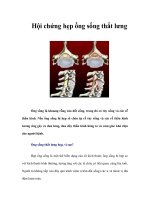Tài liệu Kidney Failure - CHOOSING A TREATMENT THAT’S RIGHT FOR YOU docx
Bạn đang xem bản rút gọn của tài liệu. Xem và tải ngay bản đầy đủ của tài liệu tại đây (561.18 KB, 35 trang )
i
Kidney Failure
CHOOSING A
T R E ATMENT THAT ’ S
R I G H TF O RYO U
National Institutes of Health
National Institute of Diabetes and Digestive and Kidney Diseases
Kidney Failure
CHOOSING A
T R E ATMENT THAT ’ S
R I G H TF O RYO U
C o n t e n t s
Introduction . . . . . . . . . . . . . . . . . . . . . . . . . . . . . . . . . . 1
When Your Kidneys Fail . . . . . . . . . . . . . . . . . . . . . . . . . . 1
Treatment Choice: Hemodialysis . . . . . . . . . . . . . . . . . . . 2
Treatment Choice: Peritoneal Dialysis . . . . . . . . . . . . . . . 9
Treatment Choice: Kidney Transplantation . . . . . . . . . . . 1 5
Treatment Choice: Refusing or Withdrawing
From Treatment . . . . . . . . . . . . . . . . . . . . . . . . . . . . . . . 2 2
Paying for Treatment . . . . . . . . . . . . . . . . . . . . . . . . . . . 2 4
Conclusion . . . . . . . . . . . . . . . . . . . . . . . . . . . . . . . . . . 2 4
Resources . . . . . . . . . . . . . . . . . . . . . . . . . . . . . . . . . . . 2 5
Acknowledgments . . . . . . . . . . . . . . . . . . . . . . . . . . . . . 2 9
1
I n t ro d u c t i o n
Your kidneys filter wastes from your blood and regulate other
functions of your body. When your kidneys fail, you need
treatment to replace the work of healthy kidneys to survive.
Developing kidney failure means that you have some decisions
to make about your treatment. If you choose to receive treat-
ment, your choices are hemodialysis, peritoneal dialysis, and
kidney transplantation. Each of them has advantages and dis-
advantages. You may also choose to forgo treatment. By
learning about your choices, you can work with your doctor
to decide what’s best for you. No matter which treatment
you choose, you’ll need to make some changes in your life,
including how you eat and plan your activities. But with the
help of your health care team, family, and friends, you can
lead a full, active life.
When Your Kidneys Fa i l
Healthy kidneys clean your blood by removing excess fluid,
minerals, and wastes. They also make hormones that keep
your bones strong and your blood healthy. When your kid-
neys fail, harmful wastes build up in your body, your blood
pressure may rise, and your body may retain excess fluid and
not make enough red blood cells. When this happens, you
need treatment to replace the work of your failed kidneys.
2
Treatment Choice: Hemodialysis
P u r p o s e
Hemodialysis cleans and filters your blood using a machine to
temporarily rid your body of harmful wastes, extra salt, and
extra water. Hemodialysis helps control blood pressure and
helps your body keep the proper balance of important chemi-
cals such as potassium, sodium, calcium, and bicarbonate.
How It Wo r k s
Hemodialysis uses a special filter called a dialyzer that func-
tions as an artificial kidney to clean your blood. During treat-
ment, your blood travels through tubes into the dialyzer,
which filters out wastes and extra water. Then the cleaned
blood flows through another set of tubes back into your body.
The dialyzer is connected to a machine that monitors blood
flow and removes wastes from the blood.
H e m o d i a l y s i s .
Heparin pump
(to prevent
c l o t t i n g )
Dialyzer inflow
pressure monitor
D i a l y z e r
A r t e r i a l
pressure monitor
Blood pump
Blood removed
for cleansing
Clean blood
returned to
b o d y
Air detector
c l a m p
Air trap and
air detector
Venous
pressure monitor
3
Hemodialysis is usually needed three times a week. Each
treatment lasts from 3 to 5 or more hours. During treatment,
you can read, write, sleep, talk, or watch TV.
Getting Ready
If you choose hemodialysis, several months before your first
treatment, an access to your bloodstream will need to be
created. You may need to stay overnight in the hospital, but
many patients have their access placed on an outpatient basis.
This access provides an efficient way for blood to be carried
from your body to the dialysis machine and back without
causing discomfort. The two main types of access are a fistula
and a graft.
• A surgeon makes a fistula
by using your own blood
vessels; an artery is con-
nected directly to a vein,
usually in your forearm.
The increased blood flow
makes the vein grow larg-
er and stronger so that it
can be used for repeated
needle insertions. This
i s the preferred type of
access. It may take several
weeks to be ready for use.
• A graft connects an artery to a vein by using a synthetic
tube. It doesn’t need to develop as a fistula does, so it
can be used sooner after placement. But a graft is more
likely to have problems with infection and clotting.
Needles are placed into the access to draw out the blood.
You’ll be given a local anesthetic to minimize any pain during
d i a l y s i s .
Arteriovenous fistula.
4
If your kidney disease has progressed quickly, you may not
have time to get a permanent vascular access before you start
hemodialysis treatments. You may need to use a catheter, a
tube inserted into a vein in your neck, chest, or leg near the
groin, as a temporary access. Some people use a catheter for
long-term access as well. Catheters that will be needed for
Catheter for temporary access.
G r a f t .
Looped graft
Ve i n
A r t e ry
5
more than about 3 weeks are designed to be placed under the
skin to increase comfort and reduce complications.
For more information about vascular access, see the N a t i o n a l
Institute of Diabetes and Digestive and Kidney Diseases
( N I D D K )fact sheet Vascular Access for Hemodialysis.
Who Performs It
Hemodialysis is usually done in a dialysis center by nurses and
trained technicians. In some parts of the country, it can be
done at home with the help of a partner, usually a family
member or friend. If you decide to do home dialysis, you
a n d your partner will receive special training.
Possible Complications
Vascular access problems are the most common reason for
hospitalization among people on hemodialysis. Common
problems include infection, blockage from clotting, and poor
blood flow. These problems can keep your treatments from
working. You may need to undergo repeated surgeries in
order to get a properly functioning access.
Other problems can be caused by rapid changes in your
b o d y’s water and chemical balance during treatment. Muscle
cramps and hypotension, or a sudden drop in blood pressure,
are two common side effects. Low blood pressure or
hypotension can make you feel weak, dizzy, or sick to your
s t o m a c h .
You’ll probably need a few months to adjust to hemodialysis.
Side effects can often be treated quickly and easily, so you
should always report them to your doctor and dialysis staff.
You can avoid many side effects if you follow a proper diet,
limit your liquid intake, and take your medicines as directed.
6
Diet for Hemodialysis
Hemodialysis and a proper diet help reduce the wastes that
build up in your blood. A dietitian is available at all dialysis
centers to help you plan meals according to your doctor’ s
orders. When choosing foods, you should remember to
• Eat balanced amounts of high-protein foods such as
meat, chicken, and fish.
• Control the amount of potassium you eat. Potassium is
a mineral found in salt substitutes, some fruits (bananas,
oranges), vegetables, chocolate, and nuts. Too much
potassium can be dangerous.
• Limit how much you drink. When your kidneys aren’t
working, water builds up quickly in your body. To o
much liquid makes your tissues swell and can lead to
high blood pressure, heart trouble, and cramps and low
blood pressure during dialysis.
• Avoid salt. Salty foods make you thirsty and make your
body hold water.
• Limit foods such as milk, cheese, nuts, dried beans, and
dark colas. These foods contain large amounts of the
mineral phosphorus. Too much phosphorus in your
blood causes calcium to be pulled from your bones,
which makes them weak and brittle and can cause
arthritis. To prevent bone problems, your doctor may
give you special medicines, which you must take with
meals every day as directed.
For more information about choosing the right foods, see the
NIDDK booklet Eat Right To Feel Right on Hemodialysis.
P ros and Cons
Each person responds differently to similar situations. What
may be a negative factor for one person may be positive for
7
I n -Center Hemodialysis
P ros
+ Facilities are widely available.
+ You have trained professionals with you at all times.
+ You can get to know other patients.
Cons
– Treatments are scheduled by the center and are rela-
tively fixed.
– You must travel to the center for treatment.
Home Hemodialysis
P ros
+ You can do it at the times you choose (but you still
must do it as often as your doctor orders).
+ You don’t have to travel to a center.
+ You gain a sense of independence and control over
your treatment.
Cons
– You must have a helper.
– Helping with treatments may be stressful to your
f a m i l y.
– You and your helper need training.
– You need space for storing the machine and supplies
at home.
8
a n o t h e r. The boxed text on page 7 lists the general advan-
tages and disadvantages of in-center and home hemodialysis.
Working With Your Health Care Te a m
Questions You May Want To Ask:
• Is hemodialysis the best treatment choice for me? Why?
• If I’m treated at a center, can I go to the center of my
choice?
• What should I look for in a dialysis center?
• Will my kidney doctor see me at dialysis?
• What does hemodialysis feel like?
• What is self-care dialysis?
• Is home hemodialysis available in my area? How long
does it take to learn? Who will train my partner and
me?
• What kind of blood access is best for me?
• As a hemodialysis patient, will I be able to keep work-
ing? Can I have treatments at night?
• How much should I exercise?
• Who will be on my health care team? How can these
people help me?
• Whom can I talk with about finances, sexuality, or
family concerns?
• How/where can I talk to other people who have faced
this decision?
For more information about hemodialysis, see the NIDDK
booklet Treatment Methods for Kidney Fa i l u re: Hemodialysis.
9
Treatment Choice: Peritoneal Dialysis
P u r p o s e
Peritoneal dialysis is another procedure that removes extra
w a t e r, wastes, and chemicals from your body. This type of
dialysis uses the lining of your abdomen to filter your blood.
This lining is called the peritoneal membrane and acts as the
artificial kidney.
How It Wo r k s
A mixture of minerals and sugar dissolved in water, called
dialysis solution, travels through a soft tube into your
abdomen. The sugar, called dextrose, draws wastes, chemi-
cals, and extra water from the tiny blood vessels in your peri-
Peritoneal dialysis.
C a t h e t e r
A b d o m i n a l
c a v i t y
Pe r i t o n e u m
D i a l y s i s
s o l u t i o n
1 0
toneal membrane into the dialysis solution. After several
hours, the used solution is drained from your abdomen
through the tube, taking the wastes from your blood with it.
Then you fill your abdomen with fresh dialysis solution, and
the cycle is repeated. Each cycle is called an exc h a n g e .
Getting Ready
Before your first treatment, a surgeon places a small, soft tube
called a catheter into your abdomen. The catheter tends to
work better if there is adequate time—usually from 10 days to
2 or 3 weeks—for the insertion site to heal. This is another
way in which planning your dialysis access can improve treat-
ment success. This catheter stays there permanently to help
transport the dialysis solution to and from your abdomen.
Types of Peritoneal Dialysis
There are three types of peritoneal dialysis.
1. Continuous Ambulatory Peritoneal Dialysis (CA P D )
CAPD is the most common type of peritoneal dialysis. It
requires no machine and can be done in any clean, well-lit
place. With CAPD, your blood is always being cleaned.
The dialysis solution passes from a plastic bag through the
catheter and into your abdomen, where it stays for several
hours with the catheter sealed. The period that dialysis
solution is in your abdomen is called the dwell time.
Next, you drain the dialysis solution back into the bag for
disposal. You then use the same catheter to refill your
abdomen with fresh dialysis solution so the cleaning
process can begin again. With CAPD, the dialysis solution
stays in your abdomen for a dwell time of 4 to 6 hours (or
more). The process of draining the used dialysis solution
and replacing it with fresh solution takes about 30 to 40
minutes. Most people change the dialysis solution at least
1 1
four times a day and sleep with solution in their abdomen
at night. With CAPD, it’s not necessary to wake up and
perform dialysis tasks during the night.
2. Continuous Cycler-Assisted Peritoneal Dialysis (CCPD)
CCPD uses a machine called a cycler to fill and empty
your abdomen three to five times during the night while
you sleep. In the morning, you begin one exchange with a
dwell time that lasts the entire day. You may do an addi-
tional exchange in the middle of the afternoon without the
cycler to increase the amount of waste removed and to
reduce the amount of fluid left behind in your body.
3. Combination of CAPD and CCPD
If you weigh more than 175 pounds or if your peritoneum
filters wastes slowly, you may need a combination of
CAPD and CCPD to get the right dialysis dose. For exam-
ple, some people use a cycler at night but also perform one
e xchange during the day. Others do four exchanges dur-
ing the day and use a minicycler to perform one or more
e xchanges during the night. You’ll work with your health
care team to determine the best schedule for you.
Who Performs It
Both types of peritoneal dialysis are usually performed by the
patient without help from a partner. CAPD is a form of self-
treatment that needs no machine. However, with CCPD, you
need a machine to drain and refill your abdomen.
Possible Complications
The most common problem with peritoneal dialysis is peri-
tonitis, a serious abdominal infection. This infection can
occur if the opening where the catheter enters your body
becomes infected or if contamination occurs as the catheter









